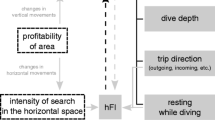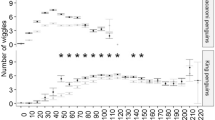Abstract
The foraging ecology of seven Gentoo penguins,Pygoscelis papua, breeding at Ardley Island, Antarctica was studied using animal-attached devices which recorded swimming speed, heading and dive depth. Reconstruction of the foraging routes by vectorial analysis of the data indicated that at no time did the birds forage on the sea bed. Swimming speed was relatively constant at 1.7 m s-1, but rates of descent and ascent in the water column during dives increased with increasing maximum dive depth due to changes in descent and ascent angles. The amount of time spent discending and ascending in the water column increased with maximum dive depth as did the duration spent at the point of maximum depth. Dive profiles were essentially either U-shaped (flat-bottomed dives), or V-shaped (bounce dives). Development of a model based on simple probability theory indicated that the optimal dive profile to maximize the chances of prey acquisition depends on vertical prey distribution and on the visual capabilities of the birds with respect to descent and ascent angles.
Similar content being viewed by others
References
Adams NJ, Wilson M-P (1987) Foraging parameters of gentoo penguins,Pygoscelis papua, at sub-Antarctic Marion Island. Polar Biol 7: 51–56
Bannasch R, Wilson RP, Culik B (1994). Hydrodynamic aspects of design and attachment of a back-mounted device in penguins. J exp Biol 194: 83–96
Bengtson JL, Croll DA, Goebel ME (1993) Diving behaviour of chinstrap penguins at Seal Island. Antarctic Sci 5: 9–15
Bengtson JL, Stewart BS (1992) Diving, and haulout behavior of crabeater seals in the Weddell Sea, Antarctica, during March 1986. Polar Biol 12: 635–644
Campagna C, Le Boeuf BJ, Blackwell SB, Crocker DE, Quintana F (1995) Diving behaviour and foraging location of female southern elephant seals from Patagonia. J Zool, Lond 236: 55–71
Croxall JP, Briggs DR, Kaito A, Naito Y, Watanuki Y, Williams TD (1993) Diving pattern and performance of the macaroni penguinEudyptes chrysolophus. J Zool, Lond 230: 31–47
Croxall JP, Lishman GS (1987) The food and feeding ecology of penguins. In: Croxall J (ed) Seabirds feeding ecology and role in marine ecosystems. Cambridge University Press, Cambridge, pp 101–134
Croxall JP, Naito Y, Kato A, Rothery P, Briggs DR (1991) Diving patterns and performance in the Antarctic blue-eyed shag,Phalacrocorax atriceps. J Zool, Lond 225: 177–199
Culik BM, Bannasch R, Wilson RP (1994a) External devices on penguins: how important is shape? Mar Biol 118: 353–357
Culik BM, Wilson RP, Bannasch R (1994b) Underwater swimming at low energetic cost by Pygoscelid penguins. J exp Biol 197: 65–78
Denton EJ (1971) Reflectors in fishes. Scient Am 224: 65–72
Denton EJ, Nicol JAC (1965) Reffection of light by external surfaces of the herring. J mar biol Ass UK 45: 711–738
Dunstone N, O'Connor RJ (1979) Optimal foraging in an amphibious mammal. I. The aqualung effect. Anim Behav 27:1182–1194
Eckert SA, Eckert KL, Ponganis P, Kooyman G L (1988) Diving and foraging behavior of leatherback sea turtles (Dermochelys coriacea). Can J Zool 67: 2834–2840
Harcourt RG, Schulman AM, Davis LS, Trillmich F (1995) Summer foraging by lactating female New Zealand fur seals (Arctocephalus forsteri) off Otago Peninsula, New Zealand. Can J Zool 73: 678–690
Houston AI, Carbone C (1992) The optimal allocation of time during the diving cycle. Behavl Ecol 3: 255–265
Kooyman GL, Cherel Y, Le Maho Y, Croxall JP, Thorson PH, Ridoux V (1992) Diving, behavior and energetics during foraging cycles in King penguins. Ecol Monogr 62: 143–163
Le Boeuf BJ, Costa DP, Huntley AC, Feldkamp SD (1988) Continuous, deep diving in female northern elephant seals,Mirounga angustirostris Can J Zool 66: 446–458
Martin AR, Smith TG (1992) Deep diving in wild, free-ranging beluga whales,Delphinapterus leucas. Can J Zool 49: 462–466
Pütz K, Bost CA (1994) Feeding behavior of free-ranging king penguins (Aptenodytes patagonicus). Ecology 65: 489–497
Thompson D, Hammond PS, Nicholas KS, Fedak M (1991) Movements, diving and foraging behaviour of grey seals (Halichoerus grypus). J Zool, Lond 224: 223–232
Thompson PM (1993) Harbour seal movements. Symp zool Soc Lond 66: 225–239
Williams TD (1995) The penguins. Oxford University Press, Oxford
Williams TD, Briggs DR, Croxall JP, Naito Y, Kato A (1992) Diving pattern and performance in relation to foraging ecology in the gentoo penguin,Pygoscelis papua. J Zool, Lond 227: 211–230
Wilson RP (1995) The foraging ecology of penguins. In: Williams T (ed) Penguins. Oxford University Press, Oxford, pp 81–106
Wilson RP, Culik BM (1992) Packages on penguins and deviceinduced data. In: Priede IM, Swift SM (eds) Wildlife telemetry: remote monitoring and tracking of animals. Ellis Horward, Chichester, UK, pp 573–580
Wilson RP, Culik BM (1995) Energetic studies of free-living seabirds: do injections of doubly-labeled water affect Gentoo penguin behavior? J fld Ornithol 66: 484–491
Wilson RP, Culik BM, Bannasch R, Driesen HH (1993) Monitoring penguins at sea using data loggers. Biotelemetry XII. Proe 12th International Symposium on Biotelemetry, Ancona, Italy. Hografia Felici, Fisa, pp 205–214
Wilson RP, Pütz K, Charrassin JB, Lage J (1995) Artifacts arising from sampling interval in dive depth studies of marine endotherms. Polar Biol 15: 575–581
Wilson RP, Wilson MP (1988) Foraging behaviour of four sympatric cormorants. J Anim Ecol 57: 943–956
Wilson RP, Wilson MP (1989) Tape: a package attachment technique for penguins. Wildl. Soc Bull 17: 77–79
Wilson RP, Wilson MP (1995) The foraging behaviour of the African penguin. In: Dann P, Norman I, Reilly P (eds) The penguins: ecology and management. Surrey Beatty and Sons, Sidney, pp 244–265
Author information
Authors and Affiliations
Additional information
Communicated by O. Kinne, Oldendorf/Luhe
Rights and permissions
About this article
Cite this article
Wilson, R.P., Culik, B.M., Peters, G. et al. Diving behaviour of gentoo penguins,Pygoscelis papua; factors keeping dive profiles in shape. Mar. Biol. 126, 153–162 (1996). https://doi.org/10.1007/BF00571387
Received:
Accepted:
Issue Date:
DOI: https://doi.org/10.1007/BF00571387




